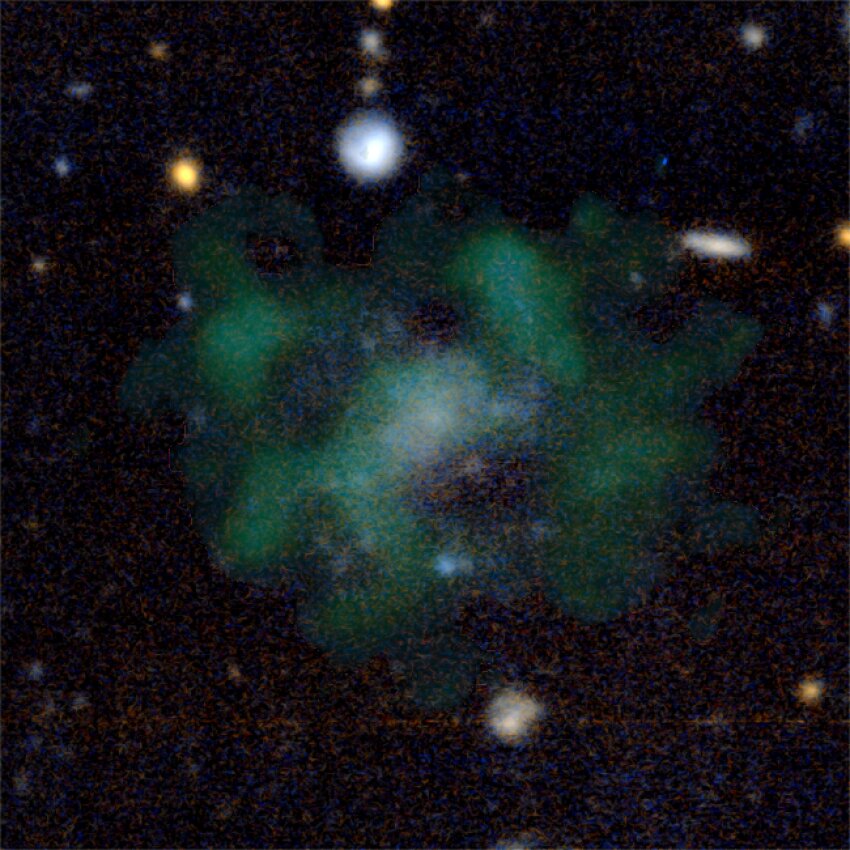

Astronomers were surprised to find a galaxy that lacks an invisible but essential piece—dark matter.
Dark matter, the mysterious theoretical substance that makes up 27 percent of our universe and doesn’t emit light, exerts a gravitational pull on regular matter. In scientists’ current picture of how a galaxy is born, dark matter is essential because it’s pull creates a base that galaxies form on.
“In our current understanding of galaxy formation, and evolution, galaxies form in the center of very massive dark matter halos,” says Pavel Mancera Piña, an astronomer at the University of Groningen and the Netherlands Institute for Radio Astronomy (ASTRON) who led a recent project studying an “ultra-diffuse” galaxy called AGC 114905, to be published in the scientific journal Monthly Notices of the Royal Astronomical Society. These dark matter halos accrete in space and help pull the galaxies together, Mancera Piña says.
That’s why it was so surprising when Mancera Piña and his team found a galaxy that they think could have formed without dark matter.
For the last few years he has been studying what are called ultra-diffuse galaxies. These galaxies, though they are about the same size as the Milky Way, have only about a thousandth of the stars. The strung-out galaxies are fainter, so astronomers hadn’t been able to observe many of them until recent advances in telescope technology, he says. But experts still don’t know how these galaxies, which have much less mass than typical galaxies, form.
The mass in a galaxy is a combination of its stars and gas, which scientists can see, but also its dark matter, which they can’t. Astronomers know that the more mass in the center of a galaxy, the faster it should rotate. But most observed galaxies rotate too fast for their apparent weight.
This is where dark matter comes in: Dark matter increases the weight of a galaxy without being visible to direct telescope observation. Knowing this, astronomers are accustomed to seeing galaxies rotating faster than expected due to dark matter’s influence.
If you can measure the heaviness of a galaxy’s stars and gas with telescopes, and compare that to the total mass of the galaxy measured by how fast it’s spinning, the difference in those numbers will tell you how much dark matter is hanging out in a galaxy. The team did this for AGC 114905. To their surprise, they found that the galaxy’s motion could be explained with regular matter alone.
[Related: Why a galaxy with no dark matter could make it hard to prove there’s no dark matter]
The team tried modeling how the most common arrangement of dark matter in a galaxy, known as a “cold dark matter halo,” would behave in this galaxy, Mancera Piña says. But simulating the typical shapes of dark matter halos didn’t produce the same results as the real-world observations, providing further evidence that AGC 114905 could exist without dark matter.
Scientists have detected a handful of other galaxies with potentially little to no dark matter, but none have as convincing data, Mancera Piña says. “I think the results show that you can have galaxies without dark matter.”
Scientists do actually know of another type of galaxy with no dark matter—one that’s formed from the tidal interaction of two galaxies, says Ignacio Trujillo, an astronomer at the Instituto de Astrofísica de Canarias in Spain, who has studied galaxies with little dark matter and was not involved with the study. The tidal pull of a neighboring galaxy can strip the dark matter from a galaxy, which explains how some galaxies might still form with dark matter, but end up with none.
Two of the previous solid candidates for dark matter lacking galaxies are Dragonfly 2 and Dragonfly 4, Trujillo says. In his opinion, one of those determinations was based on mistaken assumptions about the galaxy. The other galaxy, meanwhile, is “being tidally destroyed by a neighbor,” he says. The galaxy in this new study, however, was better characterized in terms of its distance from us and rotation speed and looks isolated, so it appears unlikely a neighboring galaxy could have stolen its dark matter.
“The study is very serious, very well done,” Trujillo says, and he agrees that this galaxy is a very strong candidate for never having had dark matter.
But as for whether this discovery will reshape the way scientists think of dark matter and galaxy formation, it’s not the end of the story, he says. He’s holding out for follow up projects that can more closely analyze this galaxy, similar to the thorough studies already completed for other prospective galaxies.
Discoveries that seem to conflict with established science are good, though, Trujillo points out. Because they push new experiments and theories forward, he says, “it’s absolutely great finding weird things.”